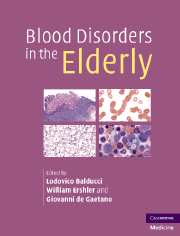Book contents
- Frontmatter
- Contents
- List of contributors
- Preface
- Part I Epidemiology
- Part II Hematopoiesis
- 5 Stem cell exhaustion and aging
- 6 Hematopoietic microenvironment and age
- 7 Replicative senescence, aging, and cancer
- 8 Qualitative changes of hematopoiesis
- 9 Aging and hematopoietic stress
- 10 Immunoglobulin response and aging
- 11 Biological and clinical significance of monoclonal gammopathy
- Part III Anemia of aging
- Part IV Hematologic malignancies and aging
- Part V Disorders of hemostasis in the elderly
- Index
9 - Aging and hematopoietic stress
from Part II - Hematopoiesis
Published online by Cambridge University Press: 21 October 2009
- Frontmatter
- Contents
- List of contributors
- Preface
- Part I Epidemiology
- Part II Hematopoiesis
- 5 Stem cell exhaustion and aging
- 6 Hematopoietic microenvironment and age
- 7 Replicative senescence, aging, and cancer
- 8 Qualitative changes of hematopoiesis
- 9 Aging and hematopoietic stress
- 10 Immunoglobulin response and aging
- 11 Biological and clinical significance of monoclonal gammopathy
- Part III Anemia of aging
- Part IV Hematologic malignancies and aging
- Part V Disorders of hemostasis in the elderly
- Index
Summary
Introduction
Aging involves a progressive decline in the functional reserve of multiple organs and systems, which reduces the stress-coping ability of aged individuals. In this chapter we explore the influence of aging on response to hematopoietic stress and the potential mechanisms by which this response may be impaired.
The peripheral blood counts do not appear significantly reduced in the aged, at least up to age 90, indicating that homeostasis is preserved even in the oldest old, in the absence of stress. In the meantime, incidence and prevalence of diseases that inhibit hematopoiesis, including chronic inflammations, nutritional deficiencies, chronic renal insufficiency, sarcopenia, myelodysplasia, and other hematopoietic malignancies, increase with age. These conditions may be subclinical until revealed by hematopoietic stress, as they prevent the increased production of blood elements required to compensate for accelerated consumption or losses. Even in the absence of specific diseases, hematopoiesis may become progressively exhausted, due to a loss of stem cells and of their self-renewal capacity. This exhaustion appears due to a number of mechanisms, including repeated exposure to anoxia/reoxygenation, epigenetic changes involving loss of DNA-repairing enzymes and of negative cell-cycle regulators, and increased concentration of substances that may inhibit the self-renewal and the differentiation of hematopoietic progenitors.
- Type
- Chapter
- Information
- Blood Disorders in the Elderly , pp. 120 - 128Publisher: Cambridge University PressPrint publication year: 2007



